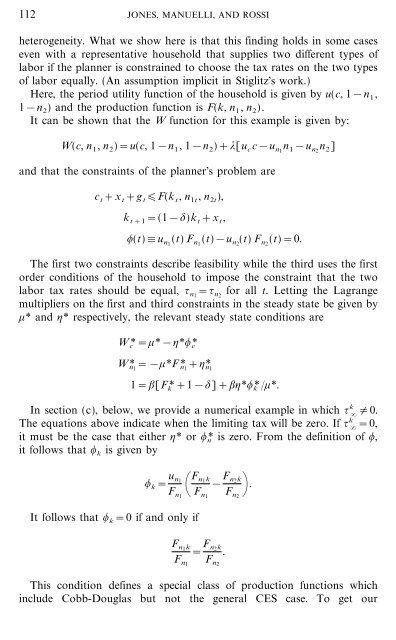On the Optimal Taxation of Capital Income
On the Optimal Taxation of Capital Income
On the Optimal Taxation of Capital Income
You also want an ePaper? Increase the reach of your titles
YUMPU automatically turns print PDFs into web optimized ePapers that Google loves.
112 JONES, MANUELLI, AND ROSSI<br />
heterogeneity. What we show here is that this finding holds in some cases<br />
even with a representative household that supplies two different types <strong>of</strong><br />
labor if <strong>the</strong> planner is constrained to choose <strong>the</strong> tax rates on <strong>the</strong> two types<br />
<strong>of</strong> labor equally. (An assumption implicit in Stiglitz's work.)<br />
Here, <strong>the</strong> period utility function <strong>of</strong> <strong>the</strong> household is given by u(c, 1&n 1,<br />
1&n 2) and <strong>the</strong> production function is F(k, n 1, n 2).<br />
It can be shown that <strong>the</strong> W function for this example is given by:<br />
W(c, n 1, n 2)=u(c,1&n 1,1&n 2)+*[u cc&u n1 n 1&u n2 n 2]<br />
and that <strong>the</strong> constraints <strong>of</strong> <strong>the</strong> planner's problem are<br />
ct+x t+g t F(kt, n1t, n2t), kt+1=(1&$)kt+xt, ,(t)#u n1 (t) F n1 (t)&u n2 (t) F n2 (t)=0.<br />
The first two constraints describe feasibility while <strong>the</strong> third uses <strong>the</strong> first<br />
order conditions <strong>of</strong> <strong>the</strong> household to impose <strong>the</strong> constraint that <strong>the</strong> two<br />
labor tax rates should be equal, { n1 ={ n2 for all t. Letting <strong>the</strong> Lagrange<br />
multipliers on <strong>the</strong> first and third constraints in <strong>the</strong> steady state be given by<br />
+* and '* respectively, <strong>the</strong> relevant steady state conditions are<br />
W c*=+*&'*, c*<br />
W* n1 =&+*F* n1 +'* n1<br />
1=;[F k*+1&$]+;'*, k* +*.<br />
In section (c), below, we provide a numerical example in which { k {0.<br />
The equations above indicate when <strong>the</strong> limiting tax will be zero. If { k =0,<br />
it must be <strong>the</strong> case that ei<strong>the</strong>r '* or, n* is zero. From <strong>the</strong> definition <strong>of</strong> ,,<br />
it follows that , k is given by<br />
, k= u n1<br />
Fn1\ Fn1k Fn1 It follows that , k=0 if and only if<br />
F n1k<br />
F n1<br />
= Fn2k .<br />
Fn2 & F n2k<br />
F n2+ .<br />
This condition defines a special class <strong>of</strong> production functions which<br />
include Cobb-Douglas but not <strong>the</strong> general CES case. To get our
















